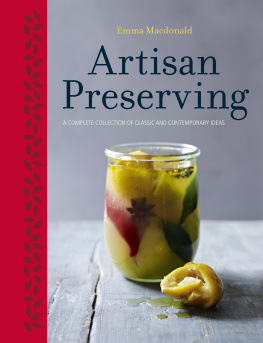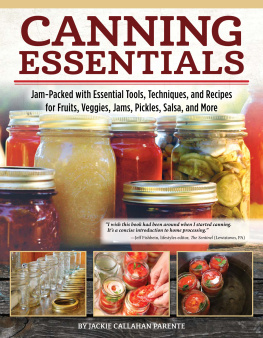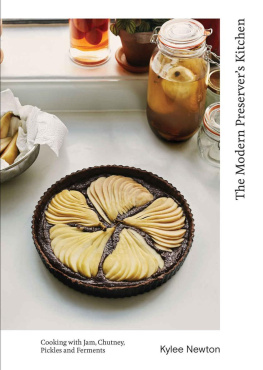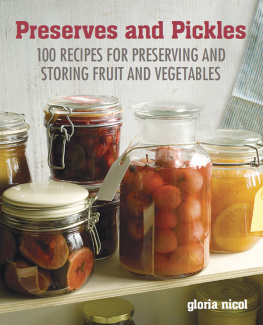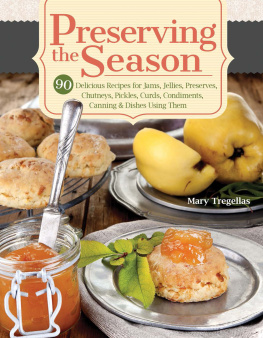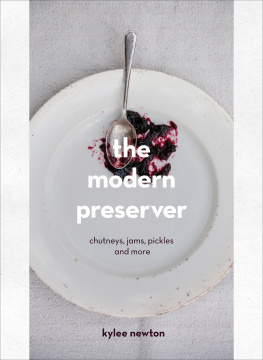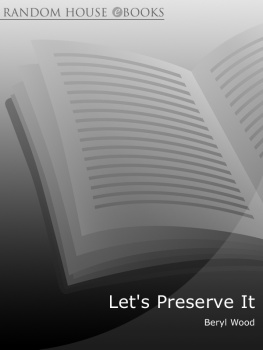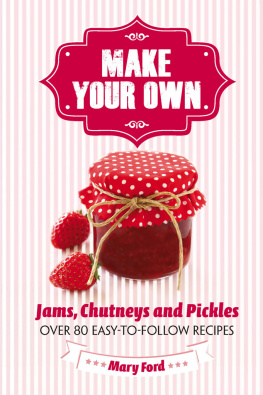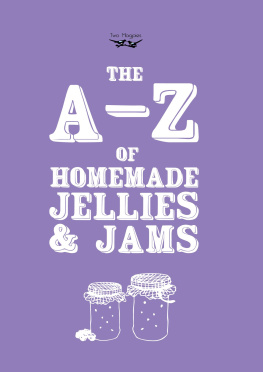

Text copyright 2015 by Kylee Newton
Photography copyright 2015 by Philippa Langley
Cover art Philippa Langley
First American Edition 2016
First published by The Random House Group Ltd. under the title
The Modern Preserver: Chutneys, pickles, jams and more
All rights reserved
For more information about permission to reproduce selections from this book, write to Permissions, The Countryman Press, 500 Fifth Avenue, New York, NY 10110
For information about special discounts for bulk purchases, please contact W. W. Norton Special Sales at specialsales@wwnorton.com or 800-233-4830
Design by Mark Evans
Food and props styling by Kylee Newton
The Countryman Press
www.countrymanpress.com
A division of W. W. Norton & Company, Inc.
500 Fifth Avenue, New York, NY 10110
www.wwnorton.com
978-1-58157-361-9
978-1-58157-524-8 (e-book)

For my Nan, Lucy May Lovegrove, and my dear friend Cameron Bain. Both of whom I lost within a week of each other while writing this book.
Nana May, your strength and love is forever with me.
Cameron, I miss you, thank you for the music.
contents

Im a New Zealander based in Hackney, East London, where I have lived and worked for the past 15 years. It is here that I began my preserves company Newton & Pott, a genuinely heartfelt kitchen table business, with jars cluttering every surface and pans bubbling on the stove. With the help of my brilliant assistant, Karolina Stein, I make everything by hand and sell my preserves at Broadway Market in Hackney on Saturdays as well as in several delis, pantries, butchers, cafs, and pubs across London.
It was about seven years ago that I first started making chutneys and preserves. I was strapped for cash and wanted to make treats as gifts. Not only did I fall in love with the process of preserving but when I presented people with a jar, they seemed surprisingly touched that it was something I had made myself. This encouraged me to start Newton & Pott so I could share that homemade sentiment with everyone.
I also wanted to waste less. My husband and I use up what we have in the fridge and cupboards. We hate to throw out food. Its a waste of money and resources, a waste of someones effort to grow, rear, nourish, or harvest that produce. In our consumer society, people unnecessarily throw things out, and expiration dates put the fear into people. But why? We are intelligent enough to judge for ourselves when something has gone bad.
Preserving is an antidote to waste. At Newton & Pott we make the most out of the seasonal harvest and produce past its expiration date, turning it into something that will last. The ethos of preserving is: saving the season and waste not, want not.
Since I started I have learned so much more about this artisan technique: what flavors work best together, the chemistry, the ins and outs of bacteria, and how things ferment. It continues to surprise and inspire me every day. In this book Ive set out to surprise and inspire you too so you can introduce preserving to your everyday life without it seeming too daunting.
Ive been cooking for as long as I can remember. My sisters and I each cooked the family meal once a week on a rotating basis, and even at age 10 I found this an exciting task: flicking through my mums 80s cookbook collection, choosing what to make, heading to the market to shop, and preparing a meal for the whole family.
My father was a fisherman; I still love to say, Im a fishermans daughter. We went on several trips out on his boat where we caught many a kahawai, red or blue cod, gurnard, and John Dory, plus the odd octopus or small shark we would have to throw back in the sea. I always remember the feeling of catching my first fish, the adrenaline that rushes through your body, and then the pride when you get home from a catch, being able to feed the whole family something that you had hunted and gathered. Dad would dive and lay crayfish traps while we waited above to see what treasures he emerged with.
Cooking for my family, especially cooking a fish I caught myself, gave me an early feel for the buzz one can get from producing food. So, as a student and when I was traveling, I took jobs in kitchens, cafs, and bars. I couldnt get enough of prepping, cooking, barista-ing, and thats how I supported myself when I first moved to London in 2001.
I made my first-ever preserve when I had been settled in London for a while. I missed home so I turned to the New Zealand cookbook The Edmonds Cookery Book. This has been a household name and cookery bible in most New Zealand homes for over 100 years and, via its tomato and apple chutney, I found a way to satisfy my nostalgia. With subsequent batches I started playing around with the flavors and adapting them to my palate: adding spices, taking away dried fruits, lessening the sugar. Now I also dry-salt the tomatoes to drain off excess liquid, and gently toast the cloves so the flavor is not too intense (see ).
Its important to be creative with your preserving. Subtract, add, adjust, develop the recipe to your own taste, and constantly learn from what you have made. There is a definite craft to making preserves, and rules to follow, but the most important thing is to play and enjoy. We are lucky this is an era with ready access to new flavors, fruits, and vegetables from around the world. Even within the last few years, unheard-of spices and herbs have become commonplace and easily available. I guess what Im trying to encourage is creativity. Let travel influence your ideas, spin that flavor wheel and try out new and interesting combinations. This has been my ethos when developing new preserves, and you can adopt it when making your own.
One of the great pleasures of preserving is, literally, giving the fruits of your labor as gifts. Having completed a fine arts degree to working as the personal printer for Turner Prizewinner Wolfgang Tillmans for 10 years before Newton & Pott, Ive become a stickler for presentation. I love the way preserving lends itself to creative styling.
My time at Wolfgangs studio in Bethnal Green exposed me to wonderful delights, both visual and culinary. We all took time to sit for 40 minutes at lunch and outdo each other with interesting and exotic flavors from around the world (there was only one English person working there). We served up dishes that ranged from German white asparagus through to ceviche and salads galore. We had oysters brought fresh from Billingsgate Market and there was talk of my miso with shiitake and udon being pipelined to the studio in Berlin when Wolfgang sadly relocated there.
This aesthetic approach to food was a valuable lesson. I realized you can stamp your individual creativity onto the look and taste of your recipes. Things should be both pretty enough to eat and so tasty that you present them at their best.
I live in an urban environment and for me that is an important fact of modern preserving. It neednt be a rural idyll; it is a craft that anyone can get into. You can buy seasonal fruit very cheaply at your local corner store or from your local farmers or produce marketand although its best to follow seasons and buy locally, these days supermarkets tend to have what you may need all year round. In Hackney, more and more people are interested in learning about artisan food techniques, and preserving is at the heart of it. People increasingly want to know what goes into their food so preserving the old-fashioned way, without additives, colorings, and preservatives, is enjoying a renaissance.
Next page

